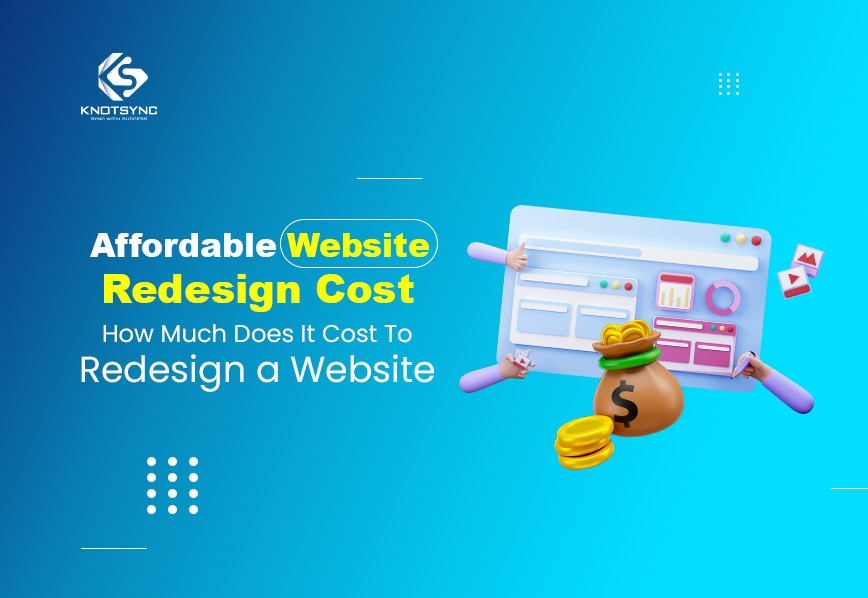Redesigning your website is like giving your site a makeover – it’s an opportunity to present a fresh face to the world. An updated, modern website makes a strong first impression on visitors and reflects well on your business. This leads to higher engagement and conversion rates. Website redesign cost depends on many factors like number of webpages, complexity of your design or urgency of work, they deliver excellent ROI by boosting your brand image, capturing more leads, and better conveying what you offer.
In this bog we will go through factors that can affect website redesign cost, find the average cost of website redesign and help you if you’re redesigning your website.
What is the Average Cost of Website Redesign?
The cost of redesigning a website varies significantly, influenced by factors such as design complexity, the number of pages, content type, features, and required customization. Estimates from different sources provide a wide range of potential expenses.
According to HubSpot, website redesign can cost an average of $12,000 to $150,000 for development and $400 to $60,000 per year for website maintenance. Another credible research from Forbes Advisor suggests expenses between $0 to $20 for domain registration, $30 to $500 for hosting, and $100 to over $5,000 for professional design, depending on the chosen platform.
However, these figures are averages, and actual costs can vary based on specific needs and market rates. It’s advisable to gather multiple quotes and understand precisely what services are included before initiating a redesign project.
What Are the Factors Affecting Your Redesign Cost?
The cost of a website redesign is influenced by several factors. Primarily, having a clear vision of what you want to redesign is crucial. The extent of the redesign, the time it takes, how often you need to update content and the technology you want to choose to revamp and get quality traffic to your website, all contribute to the overall cost. Let us now see these factors that can affect your website redesign cost in detail:
1. How Complicated the Redesign Is
If your website needs a lot of changes or has complex features, it might cost more to redesign it. The extent of changes required in the redesign process significantly affects the cost. A complete overhaul or a comprehensive redesign will be more expensive than minor updates or tweaks. It’s crucial to define the specific areas that need to be redesigned, such as visual elements, user experience, functionality, or architecture.
2. What Technolgy/Tools Are You Using
The choice of technology and tools used for the redesign can impact the overall cost. Some technologies or frameworks may require licensing fees or specialized expertise, which can increase expenses. Here is a table where you can see what technology factors can affect your overall website redesign cost:
| Technology/Tool | License/Subscription Cost | Training/Expertise Required |
| Design Software | Varies (e.g., Adobe Creative Cloud) | Yes, for complex designs |
| Front-end Frameworks | Often free (e.g., React, Angular) | Yes, for development teams |
| Back-end Frameworks | Often free (e.g., Node.js, Django) | Yes, for development teams |
| Hosting/Cloud Services | Varies (e.g., AWS, Azure, GCP) | Yes, for DevOps teams |
3. How Regularly You Need to Update Your Content
If the redesign involves updating or creating new content (text, images, videos, etc.), it can increase the overall cost. Costs may include hiring content writers, photographers, videographers, or other creative professionals. The volume of content to be updated or created also plays a role in determining the expenses. Existing content may need to be migrated, edited, or optimized for the new design, which can require additional resources.
4. Whether You Need to Integrate Third-Party API/Tools
When redesigning a website, it’s common to incorporate various third-party tools, services, or APIs to enhance functionality, performance, or user experience. Such tools can increase the cost of website redesign. Let us see different cost types that you may need to pay when integrating a third-party API:
| Cost Type | Explanation | Example |
| Integration Costs | Custom development work needed to connect the website with third-party tools or APIs. | Integrating a payment gateway or a live chat service might require custom code to ensure smooth communication and data exchange. |
| Licensing or Subscription Fees | Fees associated with using third-party tools or APIs. | A subscription to a marketing automation tool or a license for a specific image gallery plugin. |
| Usage-based Pricing | Costs that vary depending on how much a service is used. | Fees for website hosting might increase if website traffic grows significantly after the redesign. |
| Ongoing Maintenance and Updates | Costs associated with keeping integrations functional as the website and third-party tools evolve. | Updating the integration between the website and a payment gateway after the gateway releases a new security patch. |
| Training and Support | Costs for training staff on using and managing integrated tools or for ongoing support from the third-party provider. | Training developers on using a new content management system or paying for technical support from a CRM provider. |
5. Server Running Cost
After the redesign, the website will need to be hosted on a server or cloud infrastructure. Hosting costs can vary depending on the hosting provider, the required resources (storage, bandwidth, computing power), and the chosen plan or pricing model. Shared hosting plans may be more cost-effective for smaller websites, while larger or more resource-intensive sites may require dedicated servers or cloud hosting solutions, which tend to be more expensive.
Common FAQs Regarding Website Redesign
By now you must have understood how the website redesign cost varies as per your needs. Let us now check out some frequently asked question and their answers which can help you redesign your website efficiently.
1. How to Optimize Your Website Redesign?
Successfully redesigning a website within a specific time frame and budget involves careful planning and decision-making. There are two primary approaches you can consider:
- Hiring a Freelance Developer: This option is ideal if you’re looking for a quick solution or working with a limited budget. Freelancers can offer flexibility and cost-effectiveness, but the scope and quality of their work can vary greatly.
- Collaborating with a Website Development Agency: If you’re seeking comprehensive services and have a larger budget, hiring a professional agency could be the right choice. These agencies typically have a team of experts who can handle complex redesign projects and deliver high-quality results.
The choice between a freelancer and an agency should align with your redesign goals, budget, and timeline.
2. How Long Does It Take to Redesign Website?
The timeline for a website redesign can vary greatly and is largely dependent on the specific requirements of the project. According to Google, the process of designing and deploying a professionally built website could take between five and six months.
HubSpot suggests that a full website redesign takes three to six months on average. However, they also recommend starting the planning process anywhere between 90-120 days before you’d like to launch. Ahrefs, while primarily discussing SEO, indicates that significant changes to a site, such as a redesign, can take between 3-6 months to show results.
These timelines are just averages and the actual time can vary based on the complexity and scope of your redesign project.
3. How Often You Should Redesign Your Website?
The frequency of website redesigns can vary significantly, largely depending on the specific needs and goals of your business. If you are getting negative feedback related to your website design, or if users are leaving your website quicky after clicking your website then it means you need to redefine your services or objectives.
However ultimately, the decision to redesign should be strategically aligned with your business objectives, user expectations, and the dynamic digital landscape.
4. What is Most Used Technology for Website Development?
Web development technologies can be broadly categorized into front-end and back-end technologies:
Front-end Technologies:
- JavaScript: A staple in web development, used for both front-end and back-end development.
- HTML5 and CSS3: Essential for creating visually appealing and responsive websites.
- React: A popular JavaScript library for building user interfaces.
- Vue.js: Another JavaScript library popular with design and animation in field of web development.
Back-end Technologies:
- Node.js: The most used web framework among software developers worldwide.
- Django: This is a python-based backend which can easily connect with your database and frontend like react and Vue.Js.
These technologies are widely used due to their robustness, versatility, and community support. However, the choice of technology depends on the specific requirements of the project.
Conclusion
A good redesign makes your site easier to use and navigate, improving user experience. As your business evolves, your website should evolve too to remain competitive in the modern digital landscape.
Once you redesign your website, you will also need to have a dedicated team for website maintenance for ensuring a smooth and efficient post-redesign experience. Whether you need website developers to redesign your site or for website maintenance, you can contact our experienced website developers.
Remember, a well-planned website redesign can significantly enhance your website’s effectiveness. And our developers can help you create an effective and eye-catching website. Get in touch with us today to redesign your website.



